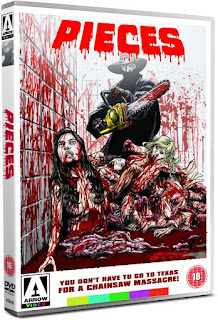House is an
interesting little set of horror films, all produced by Sean S Cunningham who
found fame with his Friday The Thirteenth franchise. They’re the sort of
low budget, often gonzo style of filmmaking which sadly would not happen today
(unless a producer had a vast budget and wasn’t afraid to spend it).
The
series starts well with House, in which a writer, Roger Cobb (William
Katt), separated from his wife as their son had gone missing while at the
house, decides to live in the house owned by his recently deceased aunt.
Strange events start to happen, culminating in Cobb being pulled through a
bathroom cabinet mirror into a strange hinterland wherein his son is trapped
... he rescues him and escapes as the house burns to the ground.
The
film is fun and irreverent in many ways, with some good ideas and effects to
keep the shocks coming ... you can see, as with nearly every film which goes to
spawn sequels, why it did so.
House II however is a
mess. It seems to have nothing to do with the first film, being far more of a
comedy into which a zombie old timer is thrust, as well as a search for a
crystal skull, and John Ratzenberger as a ‘part time adventurer’ who heads off
through a time portal ...
This installment fell flat for me. Trying to straddle comedy and horror is a fine
art, and this film failed.
House III however is much
better, even if it has even less to do with any sort of series continuity. It’s
actually very similar to another film called Shocker (released the same
year). Lance Henrickson plays a cop who put bad guy Max (Brion James) into
custody, but as the killer faces the electric chair, he seems to survive it,
transported into the electric grid and inhabiting Henrickson’s family’s house –
eventually intending to kill them all!
For
this one, I’d say forget the House tagline (which doesn’t appear on the
uncut USA print on the disk – it’s just called The Horror Show) and
enjoy the film! There’s some great
effects courtesy of Howard Berger, Robert Kurtzman and Greg Nicotero, a great
performance from Henrickson, and James plays bad guy Max to perfection. Very
enjoyable.
And
finally there’s House IV, another film which seems to have become
confused as to why it’s part of this series ... It stars William Katt (from the
first film) but as a man who gets killed in a car accident which also cripples
his daughter. His wife decides to stay in his old house, which is haunted by
ghosts. An old Native American spiritual guide
says that there’s a ‘seal’ in the basement which is keeping the spirits
trapped ... At about the half way point, the film tips on its axis and becomes
a comedy where Burke, Katt’s brother, wants to sell the house to diminutive
gangster ... There’s random effects like a shower of blood and a talking pizza,
but ultimately the film falls flat as it really doesn’t know what it wants to
be. The ending where Katt’s ‘spirit’ heads off into the sky to become a star is
just awful.
If you’re a fan of these
films then you’ll snap up this set. As always Arrow have added a host of
extras, including audio commentaries, documentaries, stills and other items of
interest.
Directed: Steve Miner (House, 1986); Ethan Wiley (House
II, 1987); James
Isaac (House III, 1989); Lewis Abernathy (House IV, 1992)
Created: Sean S Cunningham; Screenplay: Ethan
Wiley (House, House II); Allyn Warner (as Alan
Smithee) & Leslie Bohem (House
III); Geoff Miller & Deirdre Higgins (House IV)
Arrow DVD (Released 27 March 2017)




































